Here’s a fun fact:
Did you know that Colorado is home to 500+ aerospace-related businesses and suppliers, making it the second largest aerospace economy in the nation? (source: metrodenver.org) Top aerospace contractors like Ball Aerospace, Boeing, Lockheed Martin, Harris Corporation and others all have a presence in Colorado. So, what makes Colorado so attractive for aerospace companies? There are actually many reasons, but the one that stands out the most is the amount and nature of academic studies here.
Coloradans have a high college attainment rate, making the state a suitable place for aerospace companies to attract and retain top technical talent. It’s also the home of two academic institutions that offer nationally ranked aerospace programs and degrees: the University of Colorado at Boulder and The U.S. Air Force Academy in Colorado Springs. Dig a little deeper, and you’ll find numerous aerospace communities and nonprofits across the state whose mission is to promote the growth of space-related industries. One of those groups is the Colorado Business Space Roundtable (CSBR).
Recently, The 3D Printing Store invited 30 CSBR student interns to explore 3D printing and its role in the aerospace supply chain for a day. The CSBR Summer Internship is a two week program that gives students a chance to visit with different companies and get a first-hand look at what it’s like to work in different facets in the aerospace industry. Many of the interns come from rural high schools and have limited exposure to Colorado’s booming aerospace industry. We were excited to get The 3D Printing Store and Accucode 3D teams together to share our experience and expertise with everyone.
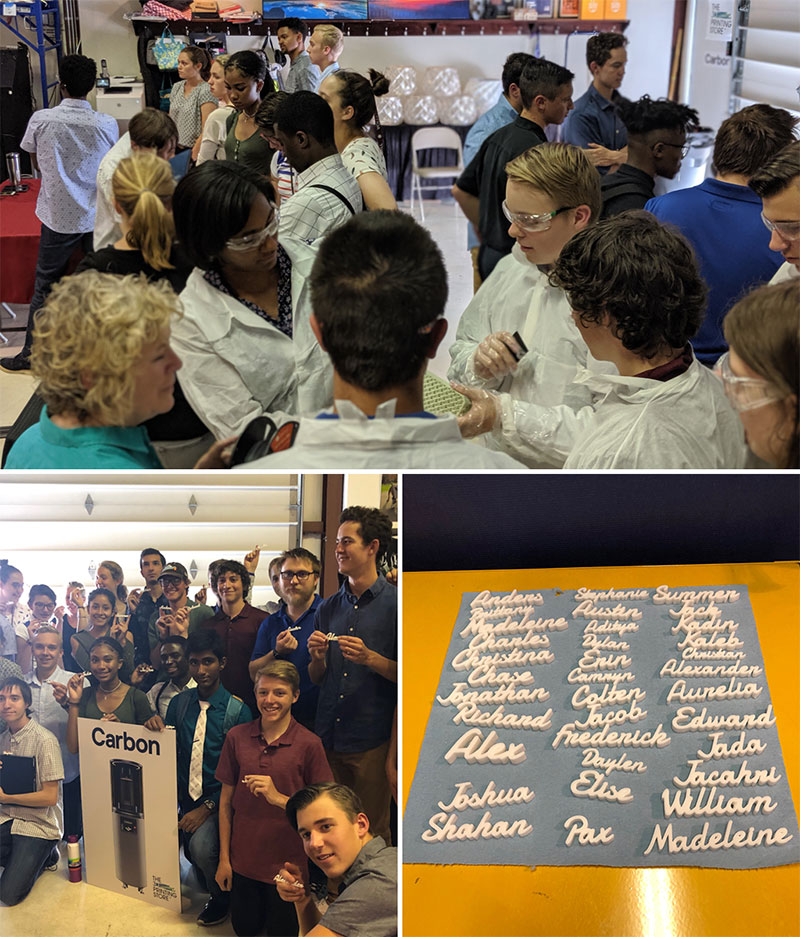
The interns got to participate in multiple hands-on activities such as Q&A with one of our engineers. Each group had one-on-one time with Daniel Braga and could ask him questions about his time working in space systems. Other activities ranged from design lessons for additive manufacturing using CAD software, to a tour of The 3D Printing Store’s Carbon 3D Lab. To wrap things up, each intern was given a 3D print of their name to take home. Our partners at Carbon 3D donated all the resin materials used to print the interns’ names and we couldn’t be more appreciative of all the support in helping us inspire the next generation of aerospace professionals.
Check out our event recap video below and let us know what you think!
To learn more about Accucode 3D or The 3D Printing Store, you can reach us here.
Also, be sure to check out The 3D Printing Store on Facebook, Linkedin, and Twitter for more company updates and the latest industry news.
Earlier this morning, The 3D Printing Store gave us a tour of their service bureau here in Centennial, CO. This was the first time many of us got to visit their location after the recent merger, so it was exciting to see the inner workings of their 3D printing operations.
It was also a chance for our marketing team to plan out their shots for an event they’ll be filming next week with a group of student interns from CSBR (Colorado Space Business Roundtable). These interns come from rural high schools and colleges across the state where access to 3D printing is limited, so it will be a great opportunity for them to learn about the different capabilities of additive manufacturing and how this technology is paving the way for new jobs and careers in the aerospace industry.
Check back soon for videos, pictures and updates from the event!

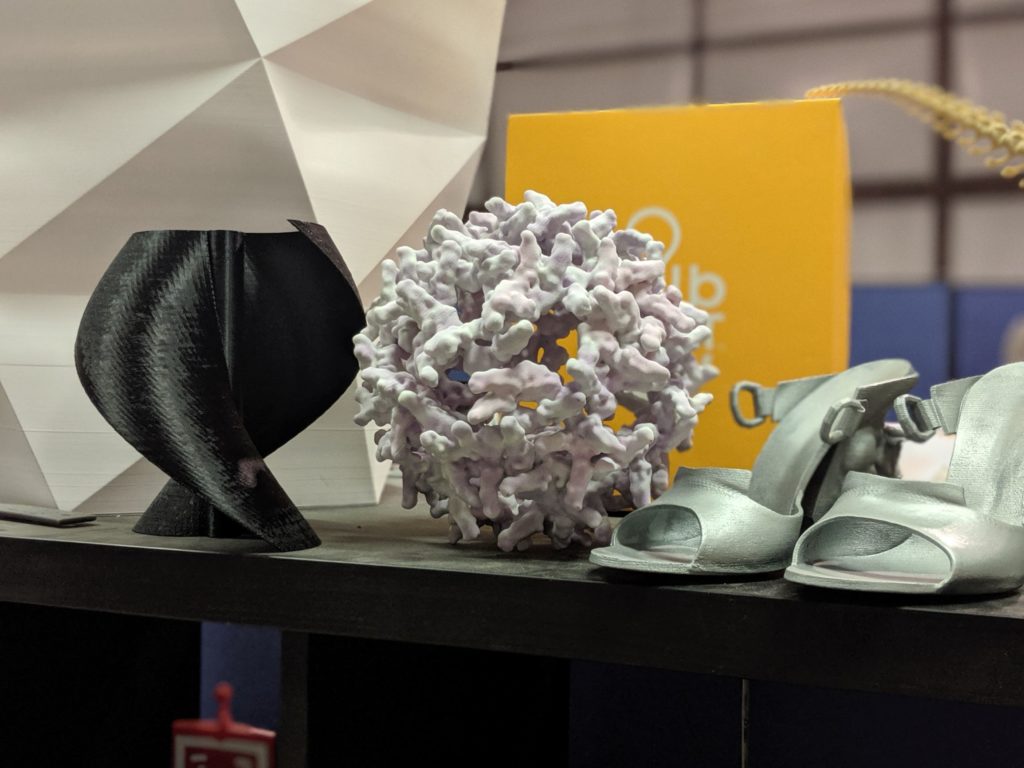
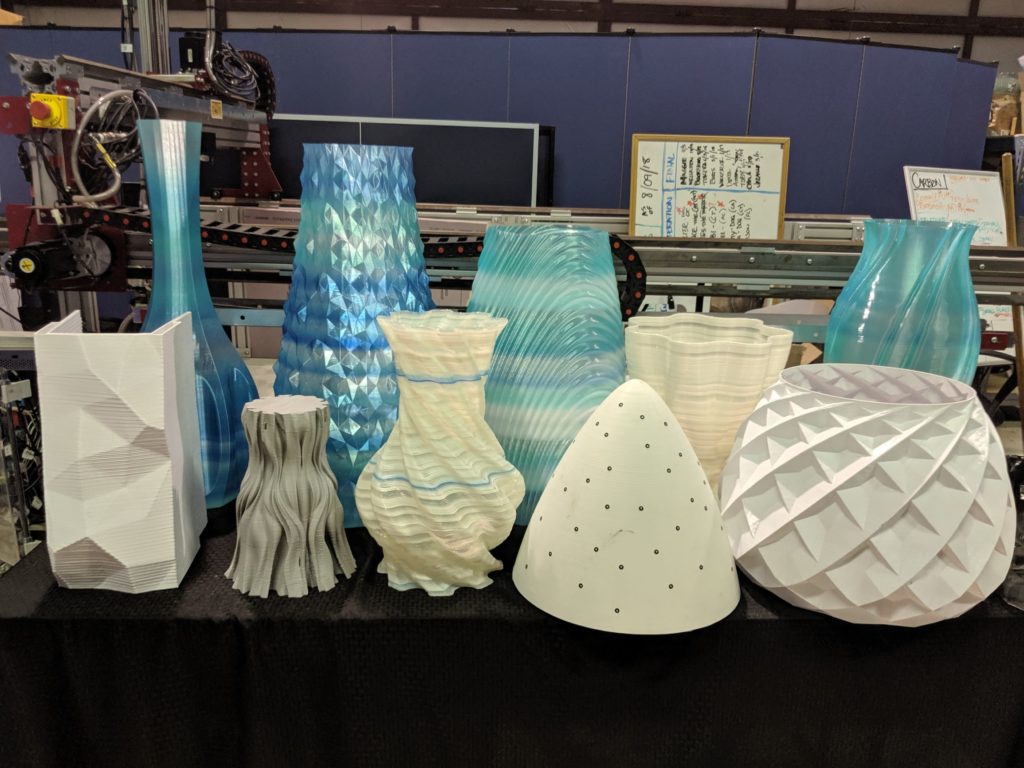
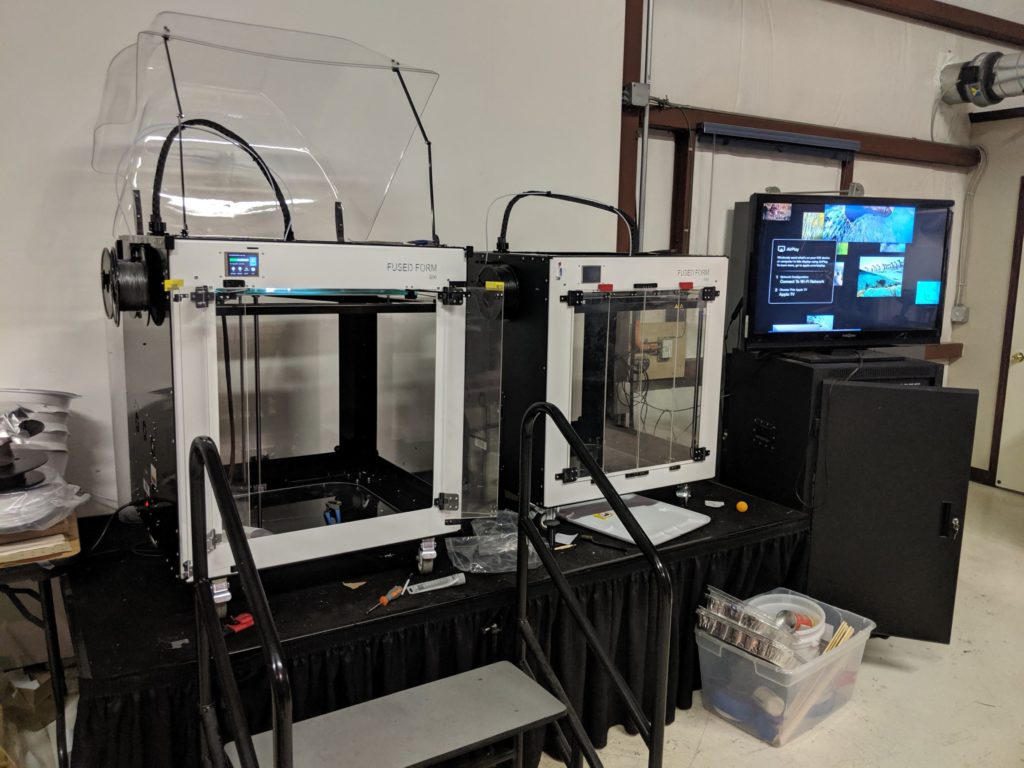
Each year, SME and the TCT Group team up to produce the largest additive manufacturing show in North America called RAPID + TCT. It attracts thousands of manufacturers and 3D printing professionals from across the country, bringing industry leaders together to educate and discuss the latest trends in additive manufacturing. The event is designed to bring change and disruption to industries that rely heavily on manufacturing, particularly automotive and medical sectors. This year was nothing short of that and Accucode 3D and The 3D Printing Store were fortunate to get a first-hand look at the different technologies reshaping the industry at this year’s event. Here’s what we discovered.
Origin Unveils Origin One 3D Printer
Overall the show was very busy, and according to the survey of attendees, there was a high number of first-time attendees. This is good for 3D vendors showing off new technologies, one of which was 3D manufacturer, Origin. We have been talking to Origin for several months now and we were excited to see the unveiling of their Origin One 3D printer used for high volume production parts. What’s unique about this printer is its open materials network which gives customers access to multiple materials that can be optimized for specific applications. One of those materials was from a company called Loctite.

Loctite Materials
Loctite, a division of Henkel Adhesive Technologies, had a significant presence at the show and showed off many materials in addition to their line of adhesives that are designed for 3D printed polymers, post processing equipment and large scale printing using a robotic arm to print floors. We discovered Henkel has a collaboration with our partner EnvisionTEC where they will be exploring new materials. We’re excited to see what new offerings emerge from this effort.

Fabrisonic
We also looked at a 3D printer from Fabrisonic that was very interesting. It offers both welding of foils of various materials and has a follow on tool head for machining. Even though we were impressed with its capabilities, this sort of technology would need to be sourced for a very specific application. We will be watching this technology closely in the coming years.
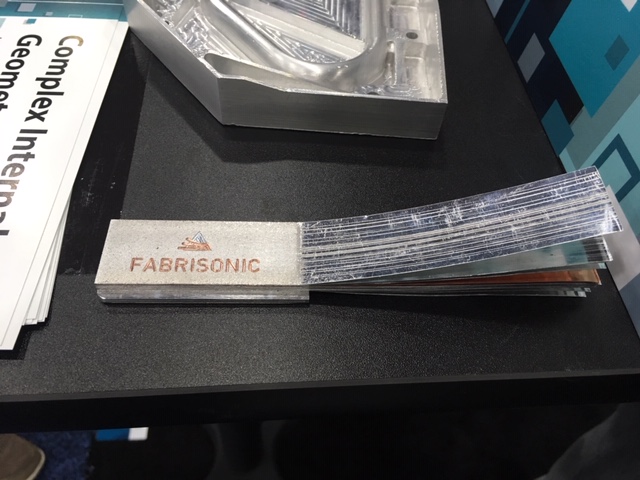
Other Notable Solutions
Given our strong focus in aerospace and automotive, many of our customers have expressed interest in 3D printing with ceramics due to its strong mechanical, chemical and thermal resistance properties. Though we don’t have ceramic printing capabilities today, we plan to add them to our stack very soon. One notable company specializing in ceramic materials at the show was a small company from Nebraska called Thethon. They offer a variety of different ceramic materials and live resins, including those used for high-temperature molding and casting of metals.
Essentium is another promising company we came across who brought their HSE 180 • S printer to the show. HSE is short for “high speed extrusion” and they are fully dedicated to both their materials and a better extrusion system. Given how slow extrusion printing processes are today, we were excited to hear the HSE 180 • S is capable of printing parts up to 10x faster than conventional FFF printers. Essentium appears to be pushing the standards for what it means to manufacture at scale without sacrificing speed or accuracy.
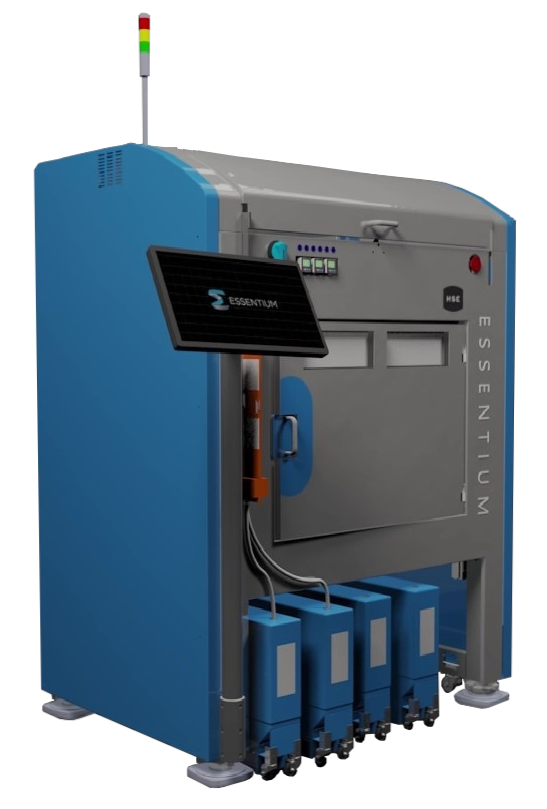
Fused Form out of Bogata, Colombia also had a great showing at RAPID + TCT this year. With large build volumes up to 500 x 500 x 600mm and a competitive price, this makes them a suitable option for engineers and schools alike. We had great discussions with their executive team at the show and we’re arranging to become a distributor for their printers here in the United States. Stay tuned for more details.
Catching Up with Partners and Customers
One of the great things about attending a major industry event like RAPID + TCT is it gives us a chance to catch-up with our partners EnvisionTEC, INTAMSYS, Nano Dimension and many others. EnvisionTEC’s annual partner conference coincided with the show, so we not only got to see what they had in store for the upcoming year but had a chance to meet the new area director for our Colorado and Texas territory.
We also got to sit down with the Prodways team. Prodways is another promising 3D printer manufacturer that we are in discussions with, so it was good to get some additional information on their industrial laser sintering printer, the ProMaker P1000. They’ll be coming out with a newer version of the P10000 in Q3 later this year called the ProMaker P1000X.
Key Takeaways
RAPID + TCT is a show we look forward to each year. This year was a bit different though in the sense that attendees were far more knowledgeable about the different technologies and materials available than we’ve seen in year’s past.
“The number of attendees familiar with 3D printing at the show was impressive. It allowed me to have more meaningful conversations with end users about their specific applications and where additive design and 3D printing would be most impactful,” says Debra Wilcox, CEO of The 3D Printing Store and Accucode 3D. “Those conversations weren’t as easy to have three years ago and I’m looking forward to continuing those discussions at the show in Anaheim next year.”
We also noticed there were just as many material manufacturers at the show as 3D printer manufacturers. That’s because the industry is seeing huge breakthroughs in the different types of materials available for additive manufacturing. What’s exciting is that many of these materials offer new properties ranging from fire resistance to thermal conductivity and RFI shielding. This opens the door for endless 3D printing applications to emerge and we’re excited to be able to help our customers innovate and solve problems in new ways with these advancements.
What was your experience like at the RAPID + TCT show this year? Was there a new material or vendor that stood out to you most? Give us a shout and let’s compare notes.
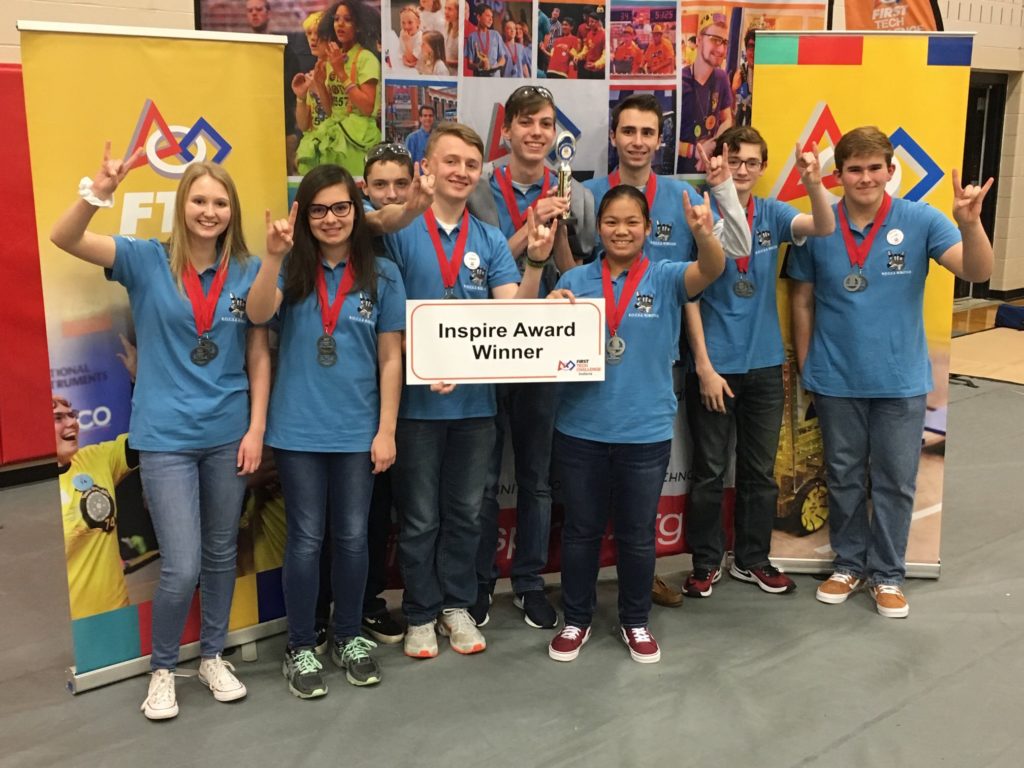
As a company, showing support for young students with a passion for science and technology is something Accucode values and encourages. This is why we were thrilled when given the opportunity to work with one of our employees, Lisa Golladay, in sponsoring her daughter’s robotics team in Louisville, KY.
Lisa’s daughter, Annie, joined the R.O.C.K.S. (Robotics Outreach Connecting Kentucky Students) Robotics team as a freshman in high school this past year. The team of 9 students (grades 8-12) are led by coaches and mentors who volunteer to help the kids design, build, program and operate a robot in head-to-head competitions through a national program called FIRST™ Tech Challenge (FTC).
The Impact of FIRST™ Tech Challenge on STEM Learning
The beautiful thing about FTC is that it’s about much more than just building a robot. The robots are a vehicle for inspiring students to learn and apply new skills in science, engineering and technology.
R.O.C.K.S. team members are split into roles based on the students’ interests and skills. Students with a passion for software development learn how to program each robot to perform certain tasks like the sorter induction system used to identify and pick-up objects off the ground. Others with a passion for design and engineering get to learn how to use SolidWorks, a popular CAD software used to design and customize different parts of the robot. So, whether students want to learn new skills or hone the ones they already have, R.O.C.K.S. has a place for every student on the team.
According to FIRST™, student alumni are 2.6 times more likely to enroll in an engineering course their freshman year and over 75% end up in a STEM-related field as a student or professional.
Check out the infographic below for a detailed look at the positive impact FIRST™ programs have on the STEM learning experience:
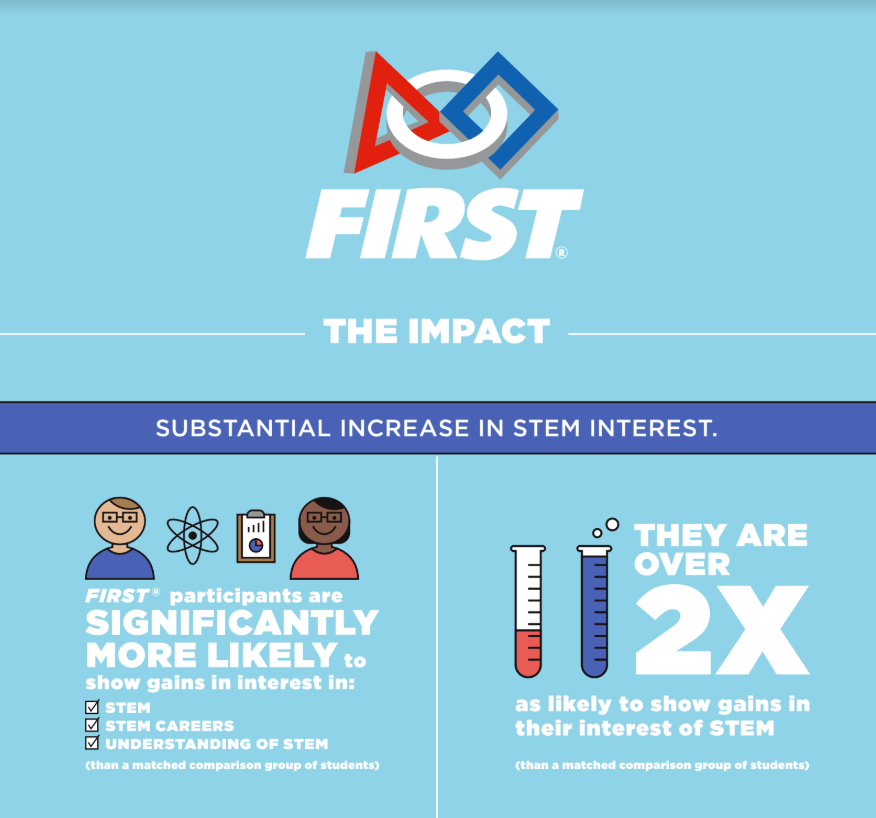
(Source: www.firstinspires.org)
Community Outreach
In addition to STEM education, FTC teaches students other important life skills, like how to create a business plan and the importance of community outreach. The R.O.C.K.S. team had to submit a business plan detailing their strategy for raising money, how those funds would be allocated to cover expenses for building the robot and how to travel to out-of-state competitions.
The team also gets involved with their community as a way to raise awareness about FIRST™ and to encourage younger kids to get excited about participating in the program. Some of the students created a comic book with simple explanations about the benefits of joining FIRST™. Others would volunteer to referee robotics competitions at local middle schools or send tutorials to the schools detailing how to start their own robotics team.
Road To Success
After months of practice and team meetings, R.O.C.K.S. was finally ready to put their robot to the test at the Indiana State Qualifier tournament held in December of 2018. During FTC tournaments, teams compete in a game called “Rover Ruckus.” The theme for this game resembles a rover landing on Mars set out to collect “minerals” from the planet for further study.
To begin the match, one person on the team has two minutes to program the robot to safely lower itself from the hanger and onto the ground. Once the robot is stable, another team member controls the robot’s movement as it goes around picking up “minerals” and returning them to the lander. Points are awarded to teams for completing certain tasks in addition to the number of minerals successfully returned to the lander.
The R.O.C.K.S. team rocked this competition and won the Inspire Award. It’s the highest award given at any FTC tournament based on overall robot performance, design, oral presentations, community outreach and visits with the judges.
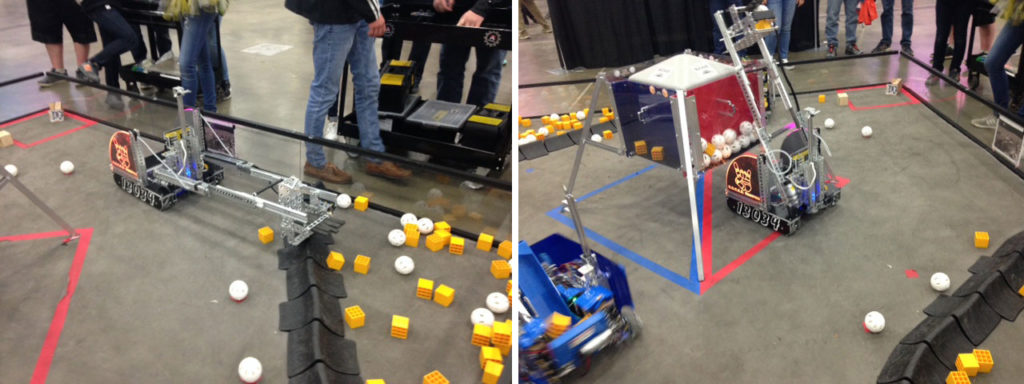
Pictures of the robot with its arm extended, collecting “mineral” with its induction system to be sorted and placed in the “Mars lander”
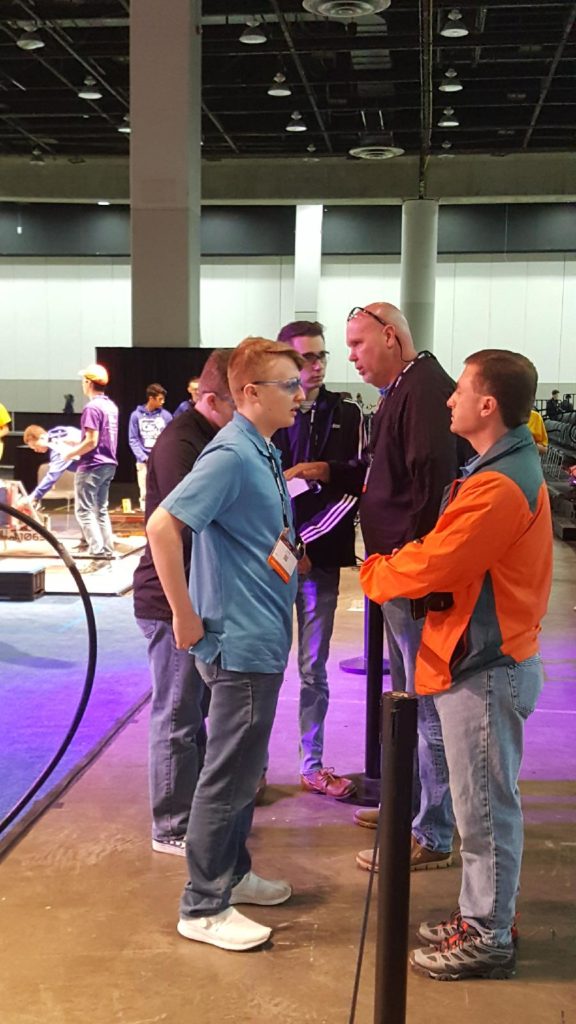
Team robot drivers being mentored by the coaches during a competition
R.O.C.K.S. would also go on to with the Inspire Award a second time at the Kentucky State Championship the following month, helping them to advance to the World Championships in April. At World’s, the team finished in 9th place out of 80 teams in the Ochoa division, bringing an end to a very successful 2018-2019 season.
We couldn’t be more proud of what these kids accomplished, not just during competitions, but the STEM skills they’ve developed along the way that they’ll be able to take with them anywhere they go, whether in business or in life.
Accucode looks forward to supporting the R.O.C.K.S. team next season and plans to get our 3D printing division more involved when the time comes to design and build next season’s robot.
Congratulations R.O.C.K.S. FTC Team #13034. You all ROCK!
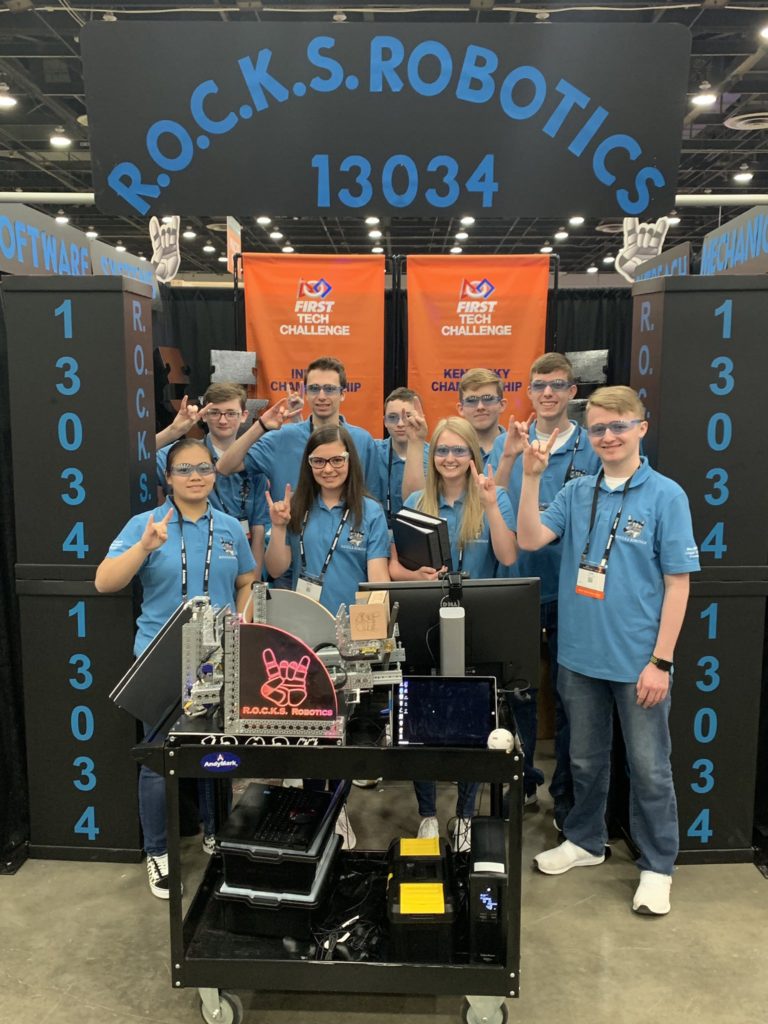
Front Row Left to Right: Annie Golladay, Anna Minton, Olivia Janssen, Cian Toole
Back Row Left to Right: Quinlan Toole, Noah Janssen, Adian Pomles, Austin Mattingly, Riley Warner
Special thanks to Lisa Golladay and the team’s coaches and mentors for all their hard work and showing support for these students throughout the season.
Originally written by Michal Swoboda for ZMorph
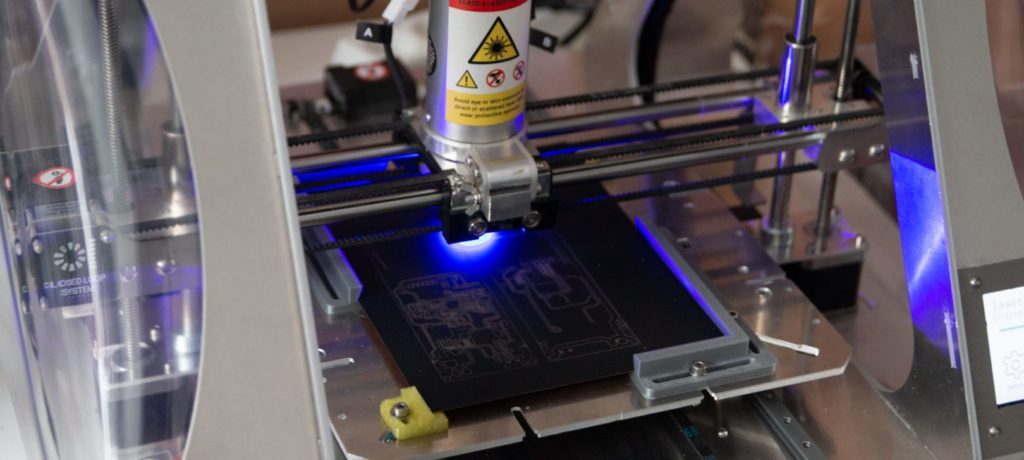
Electronic circuits are almost everywhere nowadays. They are on your wrist and in your pocket, they hide in your car, and even are present in space! Therefore there is a growing number of electronic enthusiast who wants to fulfill their creativity using knowledge and proper tools for making the most outstanding things they can imagine! But how circuit boards are made?
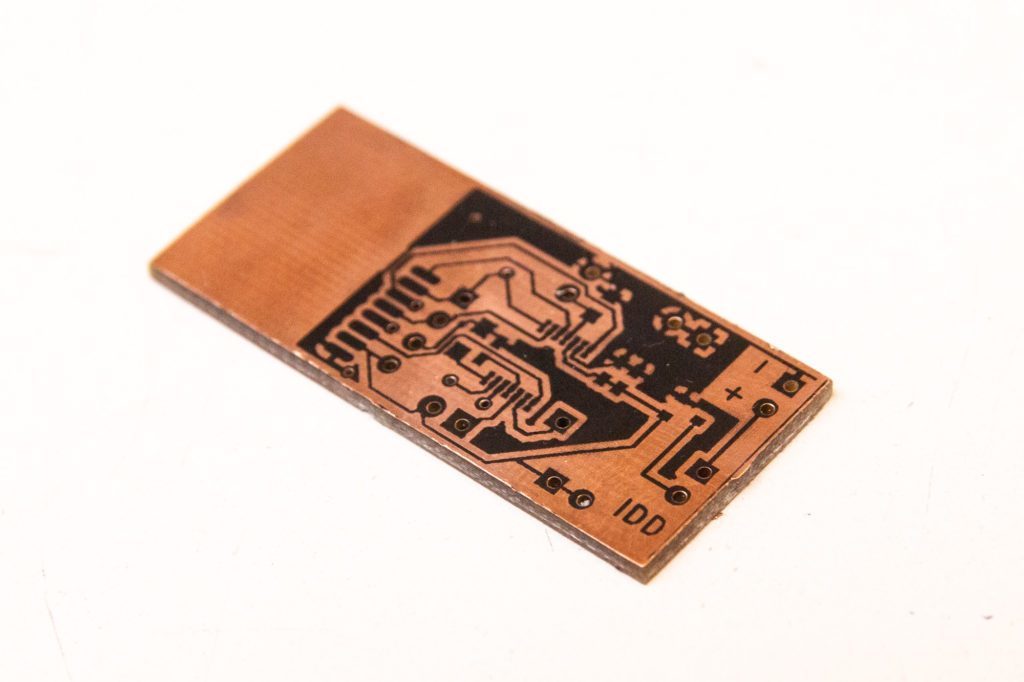
Different Types of Circuit Boards
For most it’s all starts with the idea schematic – a kind of how it works graph, that uses proper symbols for resistors, capacitors and so on.
Then it’s time for making your idea come to life. Well, there are few ways you can achieve that. Let’s start from the bottom.
You could just solder parts together using their terminals and some wire to get a messy spaghetti connected in mid-air like some sort of monster (that could still work).
Secondly, you can use breadboard that’s easy to modify and doesn’t require soldering but suffers from its fragileness. It’s easy to disconnect something and it’s often really big, and as it gets bigger, often get messier.
Next thing you can do is use a “universal board” that’s similar to a breadboard but requires soldering, which makes it more reliable if you want to utilize your circuit. The downside of this kind of board is the fact that you need to connect all the elements using wires. The bigger the circuit is the more wire is needed, and this leads to a lot of work needed to complete a circuit
Last but not least, we’ve got so-called Printed Circuit Boards or PCB for short. What’s that and why it’s the essence of all electronic circuits?
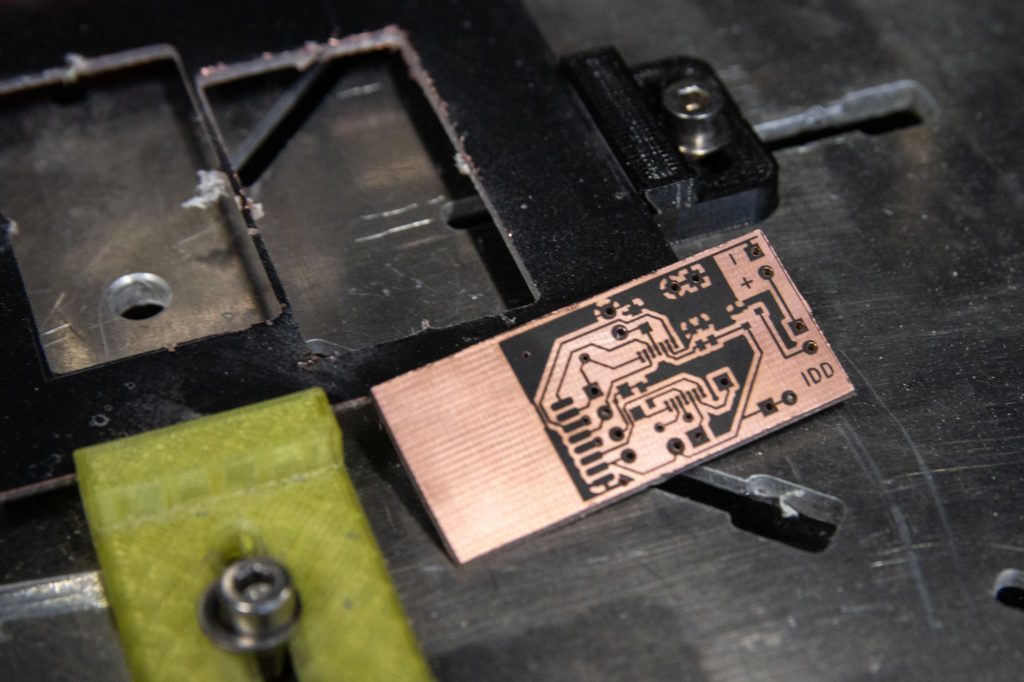
What is a PCB?
PCBs are boards that are dedicated to one special circuit that you have created, the biggest upside of such boards is the fact that they are extremely reliable, can be fitted in your design perfectly (enclosure, chassis, etc.), and lastly you can use Surface Mounted Devices (SMD) that can shrink the whole circuit a lot!
However, how do you make it? Making circuits nowadays is done using a Computer Aided Design (CAD) software, there’s are a lot of programs to choose from but I personally strongly recommend KiCAD. Using your idea schematic, you lay down tracks between components’ terminals and defining your board shape, usually, it’s a rectangle but with PCBs, you can go with lots of shapes like circles, triangles, rings, stars, banana? Why not!
Making a Custom PCB
You’re done designing an electronic circuit, but you would like to have a physical board. So how do you do it? Again, you’re not limited to just one solution. You can use various DIY methods to do this (like the Iron method), this way you can have your PCB ready at the same day, but these methods often lead to multiple tries to get a good result. It really might be frustrating. And there’s a big chance that the thinner the track the more likely it is that it won’t be properly created.
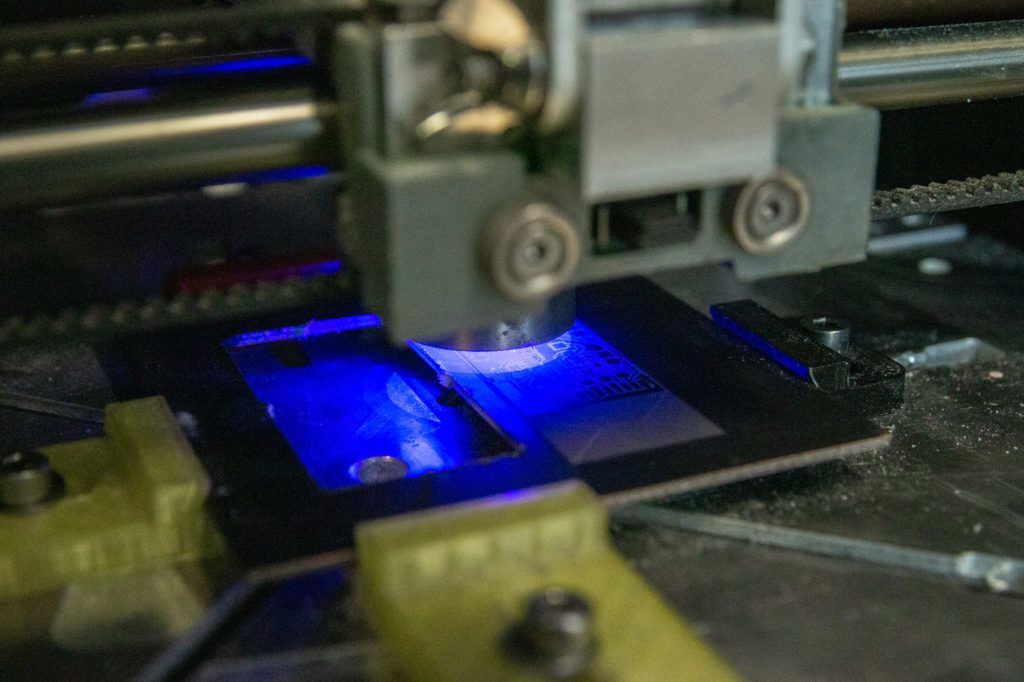
Custom PCB made on ZMorph VX
ZMorph VX and PCB Making
So are there other methods? Of course there are. You can utilize the versatile ZMorph VX for a rapid manufacture of your own Printed Circuit Board. For some of You readers, you’re familiar with milling PCB tracks using spindles. But here at ZMorph, we’ve taken a different approach. Because of multiple toolheads, we asked ourselves a question. How would the laser work, for creating tracks? There is a way to make a custom PCB with the Laser PRO toolhead and we came across a simple solution.
Making a custom PCB on ZMorph VX
Let’s cover an ordinary FR-4 copper laminate with a thin layer of ordinary matte black spray paint. That way laser beam evaporates paint leading to the revelation of copper. The laser method is easy to use, we just need to set toolhead to a proper height, which doesn’t need to be precisely trimmed. That way we can obtain a laser beam of diameter approximately 0.12 mm.
According to simple math, if our laser beam is that thin, theoretically we can achieve spacing between tracks of 5 mils. This is really tiny! And almost impossible to get in other DIY methods.
After creating laser tracks, we can switch to CNC PRO toolhead, do a little positioning check and then drill holes and mill cutout of our board. There still exist some nasty leftovers from paint evaporation process, but using a pencil rubber nice and easily gets rid of that.
Now PCB is almost ready, we just need to bathe it in the etching solution. Thanks to prior rubbering, the chemical reaction between copper and solution should be fast. All the revealed copper should be etched from the board. There’s only one last step you need to take. Clean up the spray paint with some solvent. Here you go! You’ve got yourself a PCB that’s ready for soldering.
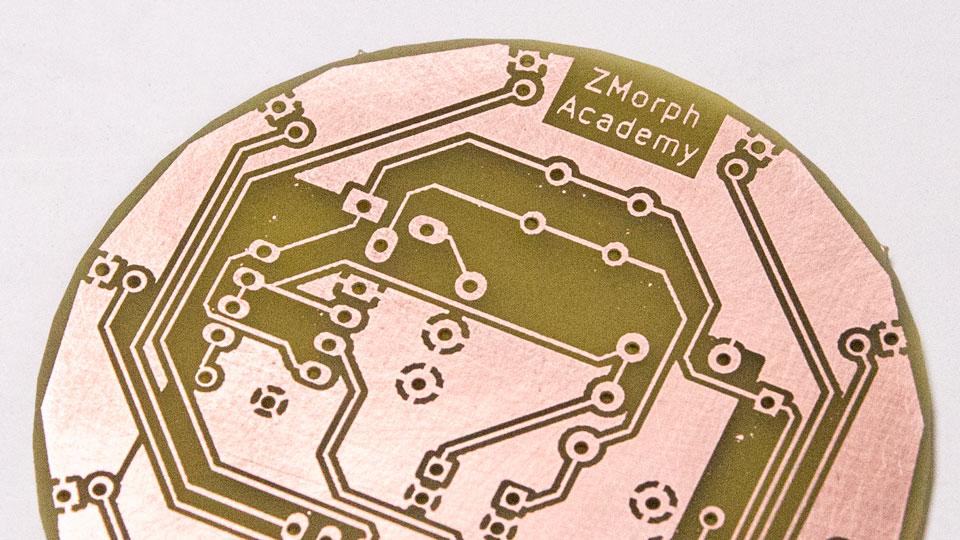
Custom PCB made on ZMorph VX
How long that it took? 2-4 hours? And for more than 80% of the time the things were done by itself! Time factor of this solution is outstanding, that’s why most of electronics prototypes that our R&D department creates are done on ZMorph VX.
If you want to get better knowledge about all processes and learn how to make a PCB using ZMorph VX, please visit the Advanced Course at ZMorph Academy.
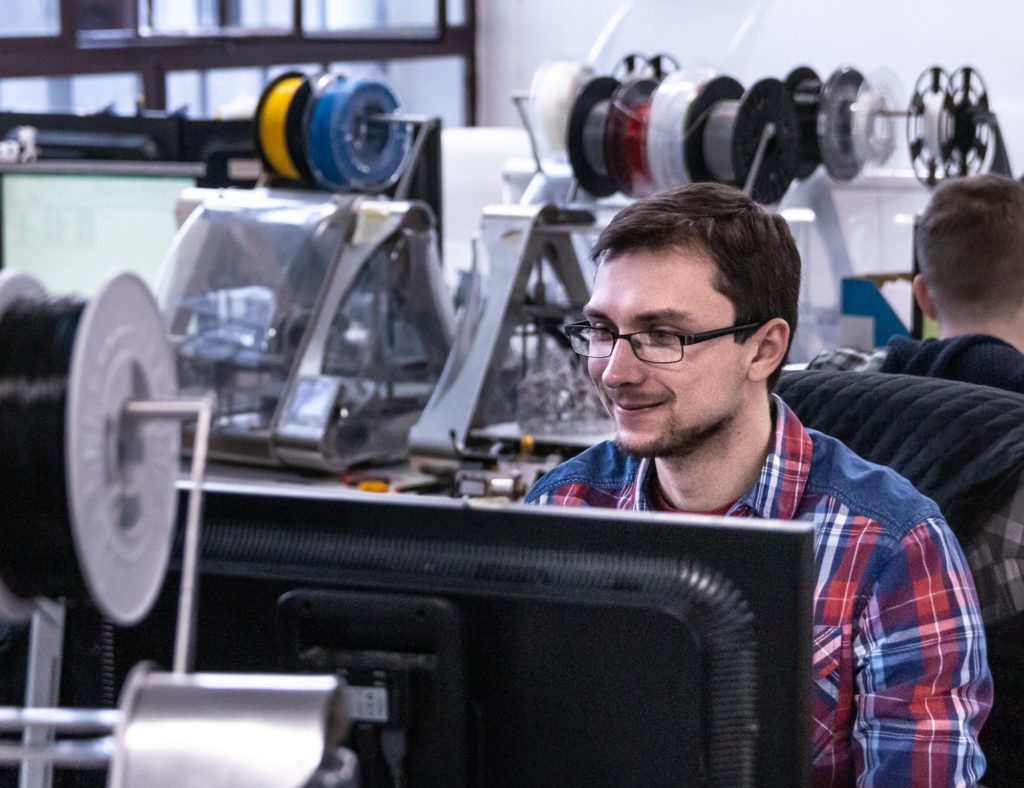
Michał Swoboda is an engineer and Embedded System Developer at ZMorph. He works at R&D department and is constantly testing new products and working on different electronics.
Click here to see the original post.
The Big Idea: Print Farms, Metal, and ADAM
Markforged continues to blaze its own path in the world of 3D printing, first with the announcement and release of the first metal desktop 3D printer priced under 100K. More recently Markforged CEO, Greg Mark, announced that their latest endeavors focus around the concept of 3D print farms. Print farms are not a new concept by any means, but this concept has seen most of its application in the realm of plastic printed materials. Before delving too far into Greg’s latest endeavors, it’s important to spend a moment discussing why the Metal X is so revolutionary. The Metal X printer is unique not because of its ability to print metal, but more so for its ability to do so in such an efficient manner. Not only is the printer more efficient than pretty much any other metal printer on the market, it’s also compact enough to fit on your desk (more on why this is such an amazing step in technological advancement later in the article) The reason the Metal X printer has taken the print world by storm is largely centered around the process in which Greg and the team at Markforged have developed for printing metal materials. The process is called Atomic Diffusion Additive Manufacturing or ADAM for short.
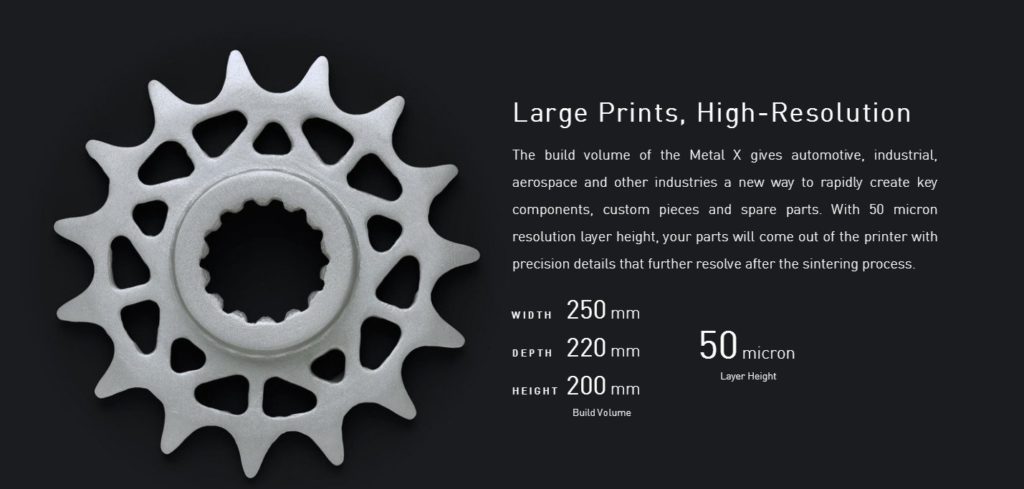
Here’s the technical definition of ADAM from Markforged’s website.
“ADAM prints your part using a bound metal powder rod that transforms into a dense metal part in one easy step. Bulk sintering provides crystal growth through all axes giving your parts excellent mechanical properties in all directions.”
Still not sure what exactly is going on? Not to worry here’s a video.
Simple enough right? Where here’s where things get all rise against the machines… Fast forward to a few days ago in Greg’s latest press conference, he’s quoted saying “The future of metal 3D printing is in print farms.” The future of printing? Really? Yes! Here’s why… Mark states that the 3D printing and additive manufacturing industry has shifted gears from focusing on creating machines that produce one of creations in a somewhat efficient manner which is more of a short-term vision, to focusing on the large term which is to replace the current “analog” methods of metal production with a more streamlined and dare I say automated approach to metal production. This digital upgrade will come in the form of a concept discussed earlier, print farms. A print farm is basically a set of printers set up to run in parallel in order to produce a particular part or pieces that make up a larger part in a more efficient manner than the current production process in use will allow. For the team at Markforged, this shift in focus came internally first. Over the past months since the release of the Metal X printer their team has assembled a prototype “print farm” which has over 100 printers running in parallel. He goes on to explain that half of the printers are dedicated to producing parts for developing new printers (which is something that you could adopt yourself if you were to purchase a printer of your own), 30 printers are used for long-term cycle testing, and 20 are used in operations to manufacture sample parts.
How Markforged Print Farms Work
The Metal X printer farm concept will utilize the advanced smart sensors built into the machine in combination with Markforged fleet management software to control the workflow of the large the number of connected printers within the network. As mentioned earlier this is largely unthreaded water in regards to 3D printing metal, but the Markforged team did have previous experience in the form of plastic 3D print farms. Take for example Voodoo manufacturing, a New York-based additive manufacturing bureau, which has stepped up an automated FFF printer farm that now operated by an autonomous arm. Stay tuned as we continue to cover all things Markforged and provide you with all your need to know information about additive printing, prototyping, and large scale manufacturing Thanks for giving this article a read, if you enjoyed it feel free to pass it along to someone else. Featured images and video are from Markforged
Authors Gilles Roucolle and Marc Boilard from Forbes deliver a report on the 3D printing spare parts supply chain more specifically that the additive manufacturing industry has started to impact the spare parts industry in a way that could change how we manufacture and distribute spare parts for the foreseeable future. Here is a snippet of the full article, which you can find here.
Using models built through computer-aided design (CAD), 3D printing can produce virtually any solid object, even those with complex architectures, and in a range of materials, including plastic, ceramic, and metal. Currently, about half of 3D printing — also known as additive manufacturing — is used for prototyping. This saves manufacturers time and money, because they can develop new components or products on-demand, with less waste and without expensive tools and molds. Industry analysts, however, project that within three years fully 80 percent of global 3D printing capacity will be dedicated to making finished products. GE, for example, expects to print 40,000 jet-fuel nozzles for aircraft by 2020.
The CST-100 Starliner and Oxford Performance Materials
Boeing plans to use more than 600 3D Printed parts in their newest spacecraft project entitled, CST-100 Starliner. The new design for the NASA Commercial Crew Development program is an attempt to broaden space travel beyond the confines of previous missions, which were led by the US-government. In order to do so, Boeing enlisted the help of Oxford Performance Materials, a small US-based 3D printing firm, to build the 3D printed parts for the new Starliner “space taxis.”
PEKK for Flexible Parts
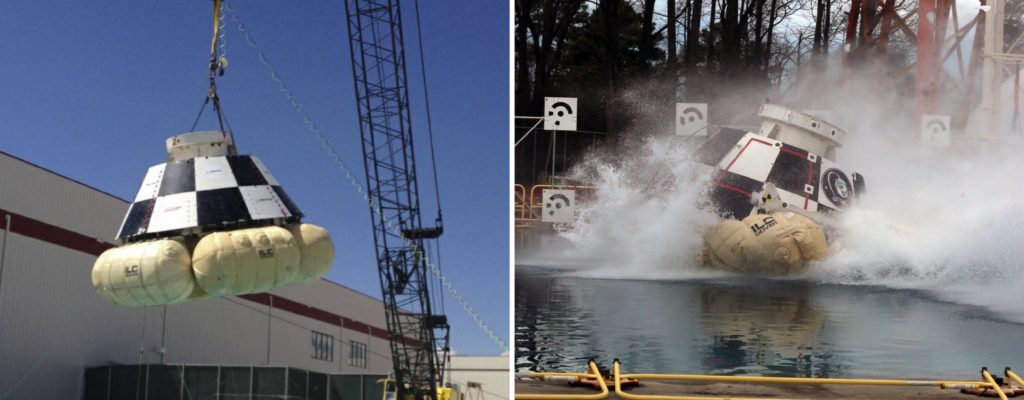
Images courtesy of NASA website
Cnet reported to Anatol Locker, an All3DP writer, in his article entitled, Boeing’s Space Taxi Will Use More than 600 3D Printed Parts that Boing has relied heavily on 3D printing since 2003. Also noting in the same article, “So far, 50,000 parts were made with additive manufacturing. She added that Oxford’s 3D-printed parts would be used the “air revitalization system, interior closeouts and support structures” of the Starliner.” Boing plans to rely on not only metal 3D printing but also wants to utilize materials such as Polyetherketoneketone (PEKK) for some of the production. This strong plastic offers additional strength and heat, radiation, and various chemical resistance, but require high temperatures in order to be printed. The Starliner is designed to transport up to seven passengers or cargo to a low-Earth orbit – like to the International Space Station. Test flights are scheduled for June 2018. The first crew will launch into space in August 2018.
Credit where credit is due
Special Thanks to Anatol, Co-founder of All3DP for compiling a large portion of the information provided in this article. Here is a little more about Anatol Locker’s company All3DP: We are a team of experienced digital entrepreneurs based in Munich, Germany. Friends, colleagues, and partners in the industry from all around the globe collaborate with All3DP. Our mission is to offer a great service that helps to promote the fascination of 3D printing to everyone.All3DP is a startup company, which has been founded in 2014 and which is well financed by leading German investors HighTech-Gründerfonds, Bayern Kapital, Deutsche Balaton AG and private investors. All3DP.com has more than 450,000 unique visitors per month (Google Analytics, Dec. 2016) and is growing rapidly.
Description taken from all3DP.com
In earlier articles we visited how 3D printing has improved prosthetics in the medical industry, today we visit Armatus Designs for a more light-hearted topic in regards to the creation of prosthetics using 3D printing.
Venom, Snakes and 3D Printing
Philadelphia University industrial design student Jackson Gordon, the founder of Armatus Designs, was asked to make a 3D printed bionic hand. The project’s design was inspired by the character Venom Snake from Metal Gear Solid 5: The Phantom PainThe project began as an upgrade for a prosthetics user. Coined the “Phantom Pain Hand” the user aimed to upgrade his prosthetic arm into something that looked better than his “claw-like arm.” Gordon was meticulous with his attention to detail. Here is a more in-depth look at what it took to develop this piece of 3D masterpiece.
More About Armatus Designs
Gordon’s design company is unique in the sense that it allows him to take on personal creative projects and help other in need of his acute expertise. Most of his previous endeavors surround costume and prop design. One of the most popular reports 3D Printing Industry author Beau Jackson, “Is the Combat Batsuit.” Here is a video demonstrating the suit in action.
This article original appears on CNN.com
It might seem like the stuff of science fiction, but that’s where 3D-printing technology is headed, according to one Dubai-based start-up. Cazza has designed a 3D-printing crane dubbed the “Minitank”, which the company says can layer up to 2,153 square feet (200 sqm) of concrete per day — making it more than 50% faster than conventional construction methods. Automating the construction process, according to Cazza, would not only allow developers to build housing in step with rapid population growth but is also better for the environment.
Teenage Dream
The mastermind behind the Minitank is a teenager. Chris Kelsey, CEO and co-founder of Cazza construction automation company, is just 19 years old, and last year used the money he made by selling his previous start-up, Appsitude, to fund his current project. As well as hiring a team of engineers experienced in the 3D printing field, Cazza also enlisted structural engineers to assess existing 3D printers in the construction world and identify where those designs could be improved. The company used this knowledge to design a series of on-site mobile 3D-printers and began testing prototypes that have informed the final design of the Minitank, which is currently under construction itself.
It’s possible to print an entire city but, of course, it will depend on the speed. Concrete is not like plastic.
– Jack Cheng, professor at the Hong Kong University of Science and Technology
Kelsey says the biggest barrier to the adoption of the Minitank — should it work when finally built — will be public misconception. “People don’t realize how much the 3D-printing world has changed,” Kelsey tells CNN. “They think that 3D printing is just (about using) plastic. People assume it won’t be structurally sound. That’s not what we do.” Over the past 15 years, 3D printing has evolved from a novelty technology for printing small toys to a sophisticated process that has transformed mega-industries from fashion to fine art. Construction, he says, is a natural progression. Jack Cheng, an associate professor in the Civil and Environmental Engineering Department at The Hong Kong University of Science and Technology, believes the technology has tremendous potential. “I think it’s real, practical technologically. It’s possible to print an entire city but, of course, it will depend on the speed. Concrete is not something — like plastic — that’s hard immediately when it prints. Concrete takes time to solidify,” he says. Cheng adds that in the United States the military has been exploring the idea of 3D printing cities after disasters, when there is a need to urgently rehouse people.
Designing Dubai
In 2016, the Dubai government announced its 3D Printing Strategy, which aims to see 25% of buildings in the city constructed using 3D printing technology by 2030. Last year, Cazza was invited by the Dubai Road and Transport Authority (RTA) to present their technology to those overseeing the initiative, the government confirms. Once based in the US, Cazza subsequently moved its headquarters to the United Arab Emirates state, which is already home to the world’s first functional 3D printed office building, constructed by a robotic arm in 17 days. Kelsey says Cazza has several projects in the pipeline in Dubai, but will not provide details. “It wouldn’t be skyscrapers right off the bat, but they really want to use our technologies for every aspect of construction,” he says. “Unless there’s a random, unique material (required) … any structure you look at that was conventionally constructed, you can print with our machines.”
Just press play
The concept of 3D printing a building was first explored seriously by Professor Behrokh Khoshnevis, director of the Center for Rapid Automated Fabrication Technologies at the University of Southern California. In 2009, Khoshnevis invented a computer-programmed, concrete-extruding 3D printer, capable of printing a 2,500-square-foot structure in 20 hours. His invention paved the way for other construction companies, such as Cazza, to experiment with 3D printing. The premise is surprisingly straight forward, requiring just a few components: the computer software, building material, and, of course, the printer. For Cazza’s process, the architect uploads their blueprint onto the computer system, which sends it to the crane printer. The latter then elegantly spins out layers of concrete in the shape of the design. “You can’t see the layering of the material in our designs,” says Kelsey. “The framework of the house is the same quality, if not higher, than the typical concrete home.”
Competition in the market
Cazza is not the first company to take inspiration from Khoshnevis, who is currently working with Nasa to explore the feasibility of printing houses on Mars. Chinese construction firm WinSun, for example, in 2014, 3D printed 10 one-story houses in a single day in Shanghai, while last year DUS architects finished printing a 13-room canal house in Amsterdam.
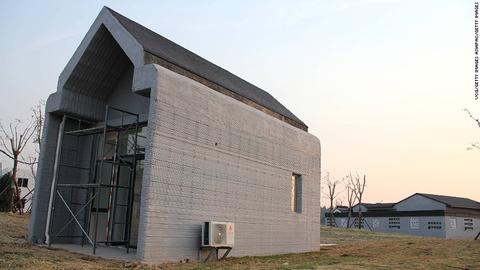
This villa in Shandong province, China, was printed in the style of a traditional Suzhou house in 2016.
The innovation behind Cazza’s technology is that the Minitank — should the company succeed in making it operational — will be able to print on-site. WinSun 3D printed the various parts of each Shanghai house off-site and assembled them on location, while DUS printed on-site but the project took three years. Cheng says seamless printing on-site is a better method of construction. “Usually, each piece of the prefabricated components look fine, but when you combine them, the workmanship isn’t that good and the connections are not stable. So the safety of some prefabricated buildings is a concern.”
Location, location, location
Printing on location is not only a faster way of working, but it cuts transportation costs and produces less waste. “The barrier to companies (printing on-site) so far has been that it’s extremely difficult to develop a machine with all of the factors needed,” says Kelsey. “There are many videos online of companies 3D printing concrete structures with their machines, but people don’t realize that these machines are not scalable for actual use in construction.” The Minitank’s crane-like neck can construct buildings up to three stories high, and the team has a new machine in the works which they say could 3D-print skyscrapers. Currently, their primary building material is a cement made from 80% recycled materials, but Kelsey says at least three other types of materials are in development
This article original appears on CNN.com


